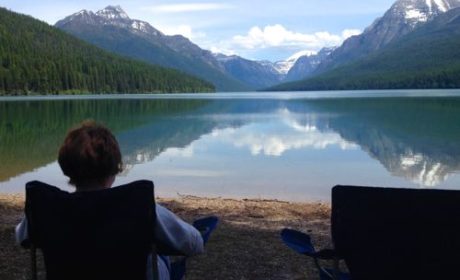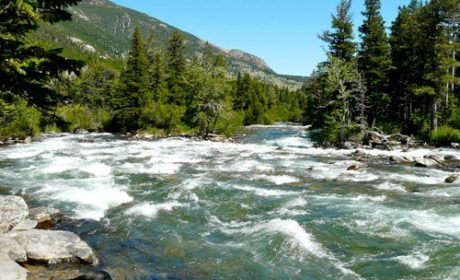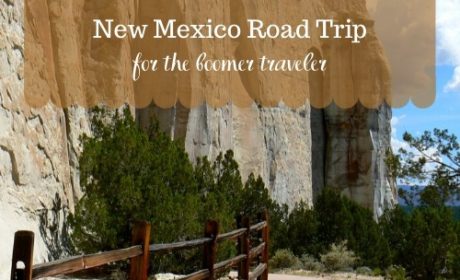On a visit to Bannack, Montana, travelers will discover gold mining history in one of the most well-preserved ghost towns in the West. Alan and I thoroughly enjoyed our all-too short visit to Bannack.
A Montana state park, Bannack Ghost Town offers historic buildings to explore, guided tours, gold panning, and a campground. And there are many special events, including ice skating on the frozen dredge pond in the winter.
Table of Contents
Directions to Bannack, Montana
The best way to get to Bannack Ghost Town is via I-15 in the southwest corner of the state. Exit west on Highway 278 south of Dillon and drive 17 miles to Bannack Bench Road. Turn left and continue for another 4 miles to the state park entrance on the right-hand side of the road.
Take your time to enjoy the off-the-beaten-path Montana scenery of Beaverhead County on the thirty-mile drive to Bannack.
But if you like remote, dirt road exploring, follow our tire tracks. Alan and I like arriving at Bannack State Park the scenic way on the Big Sheep Creek Backcountry Byway. Access to the byway is via I-15 at Dell, about 40 miles south of Dillon.
The 50-mile drive on the Big Sheep Creek Backcountry Byway is quintessential Big Sky Country. However by taking this route, you’ll only have about half a day to visit Bannack.
Bannack Ghost Town history

To say that Bannack is located in an isolated corner of Montana is an understatement. But, despite the lack of social media or even telephones, when John White discovered gold on Grasshopper Creek in 1862, prospectors and families flocked to Southwest Montana to find their fortune.
According to the Bannack State Park website (here), the population peaked in 1863 with 3,000 town residents and 2,000 more people living by the creek. In 1864, Bannack was named the First Territorial Capital of Montana. But the honor lasted only one year.
By February 1865, many of Bannack’s residents had left to mine at Alder Gulch where the nearby town of Virginia City became Montana’s capital city for the next ten years before Helena grabbed the title for good.
Things to do at Bannack State Park, a National Historic Landmark

Bannack State Park offers a fascinating look at Montana gold rush history in one of the state’s most famous mining towns. Whether you spend the entire day or get an overview during a half-day visit, the townsite offers a surprising number of things to do in a setting that’s been listed as a National Historic Landmark.
Stop at the Bannack Visitor Center first
After parking, head to the Visitor Center (open Memorial Day to Labor Day) to sign up for a tour or chat with one of the knowledgeable rangers. The center is also open on weekends during October and May.
If you’d rather tour the townsite independently, purchase a $2 self-guided photo tour pamphlet. And, while still in the Visitor Center, take time to browse the excellent selection of regional books or stop in the video room to watch a short presentation.
Visit the 60 buildings that still exist at Bannack Ghost Town

Bannack’s population fluctuated through the 1930’s but by 1950 it had become a ghost town. Luckily for history lovers, Montana State Parks, along with the Bannack Association, joined forces to preserve the 60 buildings that remain standing. Of course some buildings had already been lost to fires and the whims of nature.
Now visitors stroll the wooden sidewalks, step inside buildings for a glimpse at mining life, or marvel at how this town came to be. It’s like walking back in time.
In addition to the buildings, visit the Old Cemetery and The Gallows (a necessary structure for lawless times). The Hendricks Mill, part of the gold mining process, is also available to see by booking a tour.
Four best buildings to visit at Bannack State Park
You can go inside most of the buildings in Bannack. If you’re a photographer, try your hand at capturing the past. I’ve seen some great photos that focused on interior elements of the structures.
With so many buildings to visit, it’s impossible to explore all of them. Here are four must-sees:
Hotel Meade
Originally, this building was the Beaverhead County Courthouse, until the county seat relocated to Dillon, which was quickly becoming a regional freighting center. As mining wained, so did the town of Bannack.
In 1891, Dr. John Singleton Meade remodeled the former courthouse into a plush hotel. Considered the social hub of the community, imagine dining at Hotel Meade where the tables were set with fine china resting on beautiful linens. Operating sporadically until the 1940’s, the two-story, brick Hotel Meade would have been considered luxury lodging during the late 1800’s.
Methodist Church
The Methodist Church was the first, and only, building in Bannack constructed exclusively as a church. It was built in 1877 in thanks to God for delivering the community from an approaching Nez Perce attack that never materialized. Enter the doors to this photogenic church to imagine worship services during the town’s mining years.
Roes/Graves House
The first frame house built in Bannack, Roes/Graves House sits just west of the Meade Hotel. It was built in 1866 or 1867 by William Roe, who filed one of the first mining claims. Later, the house was purchased by F. L. Graves, whose family owned the house until the state park acquisitioned it.
Masonic Lodge and School
Probably the most photographed structure in town is the two-story white frame building that houses Bannack Masonic Lodge No. 16 (yes, the lodge is still active). The second floor was used as the lodge where visitors can see the original furnishings and carpet.
Beginning in the 1870’s, children attended school on the first floor. Step inside to imagine sitting at one of the antique desks as winds from a Montana blizzard whip through the cracks of the clapboard building. Classes were held here from 1874 through the next 70 years.
Boomer Travel Tip
The Montana Benchmark Road and Recreation Atlas is essential for exploring Montana. Here’s the latest edition.
Take a guided tour
A guided tour is the most interesting way to explore Bannack. During a one-hour tour of the mining town, not only will you go inside the buildings, you’ll hear the stories that bring them to life.
Book the 50-minute Hendricks Mill tour for visiting a restricted area in the park to learn about the mining process. You’ll arrive in a Model AA Ford Truck.
Go gold panning
Want to pan for gold? Join in a supervised activity (the only way you’ll be panning for gold at Bannack) 3:00 to 4:30 each weekend afternoon in the summer. All the mining supplies are provided. You just have to find the gold.
Attend a special event
- Bannack Days, third weekend of July, celebrates the town’s glory days.
- Living History Weekend, September, demonstrates life at the beginning of the gold rush.
- Bannack Ghost Walks, third week of October, reenacts Bannack’s spooky past.
Ice skate on the dredge pond
Winter visitors enjoy skating on the dredge pond. Rental skates are available. Warming hut opens on the weekends.
Where to stay near Bannack, MT
In Dillon, about 30 miles away, you’ll find an assortment of hotels, including a Best Western and FairBridge Inn Express (check availability here). But if you’re in a historical mood, I recommend the boutique lodging found at the Andrus Hotel, which has been housing guests since 1917.
For a more unique stay, I recommend Montana High Country Lodge or Grasshopper Inn Bed (both located in Polaris, about 16 miles from Bannack) on the Pioneer Scenic Byway. This provides easy access for soaking in Elk Horn Hot Springs, finding crystals at Crystal Park or visiting Coolidge Ghost Town. However dining options are very limited.
Jackson Hot Springs Lodge, located 30 miles away in the Big Hole Valley, offers dining (check their schedule) and the opportunity to soak in a hot springs pool. That’s our choice for next time!
If you’d like to make a vacation of it, book a vacation rental in the Big Hole Valley. This provides a centralized headquarters for visiting the ghost towns, hot springs and backroads of Southwest Montana. And there’s great fishing too!
If you’d like to stay in the Bannack State Park campground, reserve your space here.
Visit Bannack State Park on a fall trip

Autumn leaves crunch into bits of brown and gold under our feet as Alan and I walk the wooden sidewalks at. It’s only mid-September but we’ve definitely missed the prime week for fall color in this isolated corner of Southwest Montana.
Inside the Visitors Center, we discover an excellent selection of regional books, video room and a well-informed park ranger with plenty of stories to tell.
Since it’s after Labor Day, no group tours of the town or the mill are available. So we purchase a $2 self-guided walking tour guide from the ranger and off we go to explore.

Joining a smattering of weekday visitors, we explore the buildings, both inside and out, that once made up a vibrant gold rush town. History whispers to us through creaking doors, the thud of footsteps on an uneven wooden sidewalk and the rustling grass that almost covers the mining equipment rusting in a field.
The buildings and relics that have been preserved at Bannack Ghost Town help us imagine what life would have been like in the mid to late 1800’s. The printed guide provides directions, along with historical context.
Boomer Travel Tip
Visiting Montana? Start your planning at our Montana Travel Planner page.
Arriving via the 50-mile dirt road Big Sheep Backcountry Byway, our drive is filled with Montana’s big sky views. But the route doesn’t leave a lot of time to explore this fascinating ghost town.
More Montana ghost towns to explore

The American West is filled with abandoned towns that pay testament to gold rush history. There are 17 ghost towns in Southwest Montana alone.
Bannack Ghost Town is one of the best preserved — the goal is preservation not restoration. Nearby Coolidge Ghost Town, which is slowly being reclaimed by nature, offers a totally different experience. We recommend visiting both on a road trip to Southwest Montana.
Save to Pinterest




